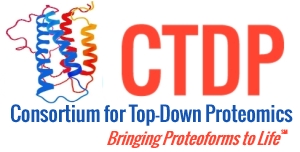“Monoclonal antibodies (mAbs) are a rapidly advancing class of therapeutic glycoproteins that possess wide clinical utility owing to their biocompatibility, high antigen specificity, and targeted immune stimulation. These therapeutic properties depend greatly on the composition of the immunoglobulin G structure, both in terms of primary sequence and post-translational modifications; however, large-scale production in cell culture often results in heterogeneous mixtures that can profoundly affect clinical safety and efficacy. This places a high demand on analytical methods that afford comprehensive structural characterization of mAbs to ensure their stringent quality control.”
4238047
{:NJWQTL8H}
annual-reviews-author-date
50
1
title
45
https://www.topdownproteomics.org/wp-content/plugins/zotpress/
Recent Publications
4238047
{4238047:A9WARQ8A},{4238047:C8X3CMGM},{4238047:4WCMS2L8},{4238047:LATPZE7L},{4238047:V8BDFXJP},{4238047:NJWQTL8H},{4238047:ECEM4A77}
annual-reviews-author-date
50
date
desc
1
title
45
https://www.topdownproteomics.org/wp-content/plugins/zotpress/
%7B%22status%22%3A%22success%22%2C%22updateneeded%22%3Afalse%2C%22instance%22%3A%22zotpress-712662d2e9bfc6cbb28760184109dcd1%22%2C%22meta%22%3A%7B%22request_last%22%3A0%2C%22request_next%22%3A0%2C%22used_cache%22%3Atrue%7D%2C%22data%22%3A%5B%7B%22key%22%3A%22NJWQTL8H%22%2C%22library%22%3A%7B%22id%22%3A4238047%7D%2C%22meta%22%3A%7B%22creatorSummary%22%3A%22Cotham%20and%20Brodbelt%22%2C%22parsedDate%22%3A%222016-04-05%22%2C%22numChildren%22%3A0%7D%2C%22bib%22%3A%22%3Cdiv%20class%3D%5C%22csl-bib-body%5C%22%20style%3D%5C%22line-height%3A%202%3B%20padding-left%3A%201em%3B%20text-indent%3A-1em%3B%5C%22%3E%5Cn%20%3Cdiv%20class%3D%5C%22csl-entry%5C%22%3ECotham%20VC%2C%20Brodbelt%20JS.%202016.%20%3Ca%20target%3D%27_blank%27%20href%3D%27http%3A%5C%2F%5C%2Fdx.doi.org%5C%2F10.1021%5C%2Facs.analchem.6b00302%27%3ECharacterization%20of%20Therapeutic%20Monoclonal%20Antibodies%20at%20the%20Subunit-Level%20using%20Middle-Down%20193%20nm%20Ultraviolet%20Photodissociation%3C%5C%2Fa%3E.%20%3Ci%3EAnal.%20Chem.%3C%5C%2Fi%3E%2088%287%29%3A4004%5Cu201313%3C%5C%2Fdiv%3E%5Cn%3C%5C%2Fdiv%3E%22%2C%22data%22%3A%7B%22itemType%22%3A%22journalArticle%22%2C%22title%22%3A%22Characterization%20of%20Therapeutic%20Monoclonal%20Antibodies%20at%20the%20Subunit-Level%20using%20Middle-Down%20193%20nm%20Ultraviolet%20Photodissociation%22%2C%22creators%22%3A%5B%7B%22creatorType%22%3A%22author%22%2C%22firstName%22%3A%22Victoria%20C.%22%2C%22lastName%22%3A%22Cotham%22%7D%2C%7B%22creatorType%22%3A%22author%22%2C%22firstName%22%3A%22Jennifer%20S.%22%2C%22lastName%22%3A%22Brodbelt%22%7D%5D%2C%22abstractNote%22%3A%22Monoclonal%20antibodies%20%28mAbs%29%20are%20a%20rapidly%20advancing%20class%20of%20therapeutic%20glycoproteins%20that%20possess%20wide%20clinical%20utility%20owing%20to%20their%20biocompatibility%2C%20high%20antigen%20specificity%2C%20and%20targeted%20immune%20stimulation.%20These%20therapeutic%20properties%20depend%20greatly%20on%20the%20composition%20of%20the%20immunoglobulin%20G%20%28IgG%29%20structure%2C%20both%20in%20terms%20of%20primary%20sequence%20and%20post-translational%20modifications%20%28PTMs%29%3B%20however%2C%20large-scale%20production%20in%20cell%20culture%20often%20results%20in%20heterogeneous%20mixtures%20that%20can%20profoundly%20affect%20clinical%20safety%20and%20efficacy.%20This%20places%20a%20high%20demand%20on%20analytical%20methods%20that%20afford%20comprehensive%20structural%20characterization%20of%20mAbs%20to%20ensure%20their%20stringent%20quality%20control.%20Here%20we%20report%20the%20use%20of%20targeted%20middle-down%20193%20nm%20ultraviolet%20photodissociation%20%28UVPD%29%20to%20provide%20detailed%20primary%20sequence%20analysis%20and%20PTM%20site%20localization%20of%20therapeutic%20monoclonal%20antibody%20subunits%20%28%5Cu223c25%20kDa%29%20generated%20upon%20digestion%20with%20recombinant%20immunoglobulin%20G-degrading%20enzyme%20of%20Streptococcus%20pyogenes%20%28IdeS%29%20followed%20by%20chemical%20reduction.%20Under%20optimal%20conditions%2C%20targeted%20UVPD%20resulted%20in%20approximately%2060%25%20overall%20coverage%20of%20the%20IgG%20sequence%2C%20in%20addition%20to%20unambiguous%20glycosylation%20site%20localization%20and%20extensive%20coverage%20of%20the%20antigen-binding%20complementarity%20determining%20regions%20%28CDRs%29%20in%20a%20single%20LC-MS%5C%2FMS%20experiment.%20Combining%20UVPD%20and%20ETD%20data%20afforded%20even%20deeper%20sequencing%20and%20greater%20overall%20characterization%20of%20IgG%20subunits.%20Overall%2C%20this%20targeted%20UVPD%20approach%20represents%20a%20promising%20new%20strategy%20for%20the%20comprehensive%20characterization%20of%20antibody-based%20therapeutics.%22%2C%22date%22%3A%22April%205%2C%202016%22%2C%22language%22%3A%22%22%2C%22DOI%22%3A%2210.1021%5C%2Facs.analchem.6b00302%22%2C%22ISSN%22%3A%220003-2700%22%2C%22url%22%3A%22http%3A%5C%2F%5C%2Fdx.doi.org%5C%2F10.1021%5C%2Facs.analchem.6b00302%22%2C%22collections%22%3A%5B%5D%2C%22dateModified%22%3A%222017-09-08T14%3A56%3A48Z%22%7D%7D%2C%7B%22key%22%3A%22ECEM4A77%22%2C%22library%22%3A%7B%22id%22%3A4238047%7D%2C%22meta%22%3A%7B%22creatorSummary%22%3A%22Resemann%20et%20al.%22%2C%22parsedDate%22%3A%222016-02-17%22%2C%22numChildren%22%3A0%7D%2C%22bib%22%3A%22%3Cdiv%20class%3D%5C%22csl-bib-body%5C%22%20style%3D%5C%22line-height%3A%202%3B%20padding-left%3A%201em%3B%20text-indent%3A-1em%3B%5C%22%3E%5Cn%20%3Cdiv%20class%3D%5C%22csl-entry%5C%22%3EResemann%20A%2C%20Jabs%20W%2C%20Wiechmann%20A%2C%20Wagner%20E%2C%20Colas%20O%2C%20et%20al.%202016.%20%3Ca%20target%3D%27_blank%27%20href%3D%27http%3A%5C%2F%5C%2Fdx.doi.org%5C%2F10.1080%5C%2F19420862.2015.1128607%27%3EFull%20validation%20of%20therapeutic%20antibody%20sequences%20by%20middle-up%20mass%20measurements%20and%20middle-down%20protein%20sequencing%3C%5C%2Fa%3E.%20%3Ci%3EmAbs%3C%5C%2Fi%3E.%208%282%29%3A318%5Cu201330%3C%5C%2Fdiv%3E%5Cn%3C%5C%2Fdiv%3E%22%2C%22data%22%3A%7B%22itemType%22%3A%22journalArticle%22%2C%22title%22%3A%22Full%20validation%20of%20therapeutic%20antibody%20sequences%20by%20middle-up%20mass%20measurements%20and%20middle-down%20protein%20sequencing%22%2C%22creators%22%3A%5B%7B%22creatorType%22%3A%22author%22%2C%22firstName%22%3A%22Anja%22%2C%22lastName%22%3A%22Resemann%22%7D%2C%7B%22creatorType%22%3A%22author%22%2C%22firstName%22%3A%22Wolfgang%22%2C%22lastName%22%3A%22Jabs%22%7D%2C%7B%22creatorType%22%3A%22author%22%2C%22firstName%22%3A%22Anja%22%2C%22lastName%22%3A%22Wiechmann%22%7D%2C%7B%22creatorType%22%3A%22author%22%2C%22firstName%22%3A%22Elsa%22%2C%22lastName%22%3A%22Wagner%22%7D%2C%7B%22creatorType%22%3A%22author%22%2C%22firstName%22%3A%22Olivier%22%2C%22lastName%22%3A%22Colas%22%7D%2C%7B%22creatorType%22%3A%22author%22%2C%22firstName%22%3A%22Waltraud%22%2C%22lastName%22%3A%22Evers%22%7D%2C%7B%22creatorType%22%3A%22author%22%2C%22firstName%22%3A%22Eckhard%22%2C%22lastName%22%3A%22Belau%22%7D%2C%7B%22creatorType%22%3A%22author%22%2C%22firstName%22%3A%22Lars%22%2C%22lastName%22%3A%22Vorwerg%22%7D%2C%7B%22creatorType%22%3A%22author%22%2C%22firstName%22%3A%22Catherine%22%2C%22lastName%22%3A%22Evans%22%7D%2C%7B%22creatorType%22%3A%22author%22%2C%22firstName%22%3A%22Alain%22%2C%22lastName%22%3A%22Beck%22%7D%2C%7B%22creatorType%22%3A%22author%22%2C%22firstName%22%3A%22Detlev%22%2C%22lastName%22%3A%22Suckau%22%7D%5D%2C%22abstractNote%22%3A%22The%20regulatory%20bodies%20request%20full%20sequence%20data%20assessment%20both%20for%20innovator%20and%20biosimilar%20monoclonal%20antibodies%20%28mAbs%29.%20Full%20sequence%20coverage%20is%20typically%20used%20to%20verify%20the%20integrity%20of%20the%20analytical%20data%20obtained%20following%20the%20combination%20of%20multiple%20LC-MS%5C%2FMS%20datasets%20from%20orthogonal%20protease%20digests%20%28so%20called%20%5Cu201cbottom-up%5Cu201d%20approaches%29.%20Top-down%20or%20middle-down%20mass%20spectrometric%20approaches%20have%20the%20potential%20to%20minimize%20artifacts%2C%20reduce%20overall%20analysis%20time%20and%20provide%20orthogonality%20to%20this%20traditional%20approach.%20In%20this%20work%20we%20report%20a%20new%20combined%20approach%20involving%20middle-up%20LC-QTOF%20and%20middle-down%20LC-MALDI%20in-source%20decay%20%28ISD%29%20mass%20spectrometry.%20This%20was%20applied%20to%20cetuximab%2C%20panitumumab%20and%20natalizumab%2C%20selected%20as%20representative%20US%20Food%20and%20Drug%20Administration-%20and%20European%20Medicines%20Agency-approved%20mAbs.%20The%20goal%20was%20to%20unambiguously%20confirm%20their%20reference%20sequences%20and%20examine%20the%20general%20applicability%20of%20this%20approach.%20Furthermore%2C%20a%20new%20measure%20for%20assessing%20the%20integrity%20and%20validity%20of%20results%20from%20middle-down%20approaches%20is%20introduced%20%5Cu2013%20the%20%5Cu201cSequence%20Validation%20Percentage.%5Cu201d%20Full%20sequence%20data%20assessment%20of%20the%203%20antibodies%20was%20achieved%20enabling%20all%203%20sequences%20to%20be%20fully%20validated%20by%20a%20combination%20of%20middle-up%20molecular%20weight%20determination%20and%20middle-down%20protein%20sequencing.%20Three%20errors%20in%20the%20reference%20amino%20acid%20sequence%20of%20natalizumab%2C%20causing%20a%20cumulative%20mass%20shift%20of%20only%20%5Cu22122%20Da%20in%20the%20natalizumab%20Fd%20domain%2C%20were%20corrected%20as%20a%20result%20of%20this%20work.%22%2C%22date%22%3A%22February%2017%2C%202016%22%2C%22language%22%3A%22%22%2C%22DOI%22%3A%2210.1080%5C%2F19420862.2015.1128607%22%2C%22ISSN%22%3A%221942-0862%22%2C%22url%22%3A%22http%3A%5C%2F%5C%2Fdx.doi.org%5C%2F10.1080%5C%2F19420862.2015.1128607%22%2C%22collections%22%3A%5B%5D%2C%22dateModified%22%3A%222017-09-08T15%3A00%3A11Z%22%7D%7D%2C%7B%22key%22%3A%22V8BDFXJP%22%2C%22library%22%3A%7B%22id%22%3A4238047%7D%2C%22meta%22%3A%7B%22creatorSummary%22%3A%22Pan%20et%20al.%22%2C%22parsedDate%22%3A%222015-06-16%22%2C%22numChildren%22%3A0%7D%2C%22bib%22%3A%22%3Cdiv%20class%3D%5C%22csl-bib-body%5C%22%20style%3D%5C%22line-height%3A%202%3B%20padding-left%3A%201em%3B%20text-indent%3A-1em%3B%5C%22%3E%5Cn%20%3Cdiv%20class%3D%5C%22csl-entry%5C%22%3EPan%20J%2C%20Zhang%20S%2C%20Chou%20A%2C%20Hardie%20DB%2C%20Borchers%20CH.%202015.%20%3Ca%20target%3D%27_blank%27%20href%3D%27http%3A%5C%2F%5C%2Fdx.doi.org%5C%2F10.1021%5C%2Fac504809r%27%3EFast%20Comparative%20Structural%20Characterization%20of%20Intact%20Therapeutic%20Antibodies%20Using%20Hydrogen%5Cu2013Deuterium%20Exchange%20and%20Electron%20Transfer%20Dissociation%3C%5C%2Fa%3E.%20%3Ci%3EAnal.%20Chem.%3C%5C%2Fi%3E%2087%2812%29%3A5884%5Cu201390%3C%5C%2Fdiv%3E%5Cn%3C%5C%2Fdiv%3E%22%2C%22data%22%3A%7B%22itemType%22%3A%22journalArticle%22%2C%22title%22%3A%22Fast%20Comparative%20Structural%20Characterization%20of%20Intact%20Therapeutic%20Antibodies%20Using%20Hydrogen%5Cu2013Deuterium%20Exchange%20and%20Electron%20Transfer%20Dissociation%22%2C%22creators%22%3A%5B%7B%22creatorType%22%3A%22author%22%2C%22firstName%22%3A%22Jingxi%22%2C%22lastName%22%3A%22Pan%22%7D%2C%7B%22creatorType%22%3A%22author%22%2C%22firstName%22%3A%22Suping%22%2C%22lastName%22%3A%22Zhang%22%7D%2C%7B%22creatorType%22%3A%22author%22%2C%22firstName%22%3A%22Albert%22%2C%22lastName%22%3A%22Chou%22%7D%2C%7B%22creatorType%22%3A%22author%22%2C%22firstName%22%3A%22Darryl%20B.%22%2C%22lastName%22%3A%22Hardie%22%7D%2C%7B%22creatorType%22%3A%22author%22%2C%22firstName%22%3A%22Christoph%20H.%22%2C%22lastName%22%3A%22Borchers%22%7D%5D%2C%22abstractNote%22%3A%22Higher-order%20structural%20characterization%20plays%20an%20important%20role%20in%20many%20stages%20of%20therapeutic%20antibody%20production.%20Herein%2C%20we%20report%20a%20new%20top-down%20mass%20spectrometry%20approach%20for%20characterizing%20the%20higher-order%20structure%20of%20intact%20antibodies%2C%20by%20combining%20hydrogen%5C%2Fdeuterium%20exchange%20%28HDX%29%2C%20subzero%20temperature%20chromatography%2C%20and%20electron%20transfer%20dissociation%20on%20the%20Orbitrap%20mass%20spectrometer.%20Individual%20IgG%20domain-level%20deuteration%20information%20was%20obtained%20for%206%20IgG%20domains%20on%20Herceptin%20%28HER%29%2C%20which%20included%20the%20antigen%20binding%20sites.%20This%20is%20the%20first%20time%20that%20top-down%20HDX%20has%20been%20applied%20to%20an%20intact%20protein%20as%20large%20as%20150%20kDa%2C%20which%20has%20never%20been%20done%20before%20on%20any%20instrument.%20Ligand-binding%20induced%20structural%20differences%20in%20HER%20were%20determined%20to%20be%20located%20only%20on%20the%20variable%20region%20of%20the%20light%20chain.%20Global%20glycosylation%20profile%20of%20antibodies%20and%20HDX%20property%20of%20the%20glycoforms%20were%20also%20determined%20by%20accurate%20intact%20mass%20measurements.%20Although%20the%20presence%20of%20disulfide%20bonds%20prevent%20the%20current%20approach%20from%20being%20able%20to%20obtain%20amino%20acid%20level%20structural%20information%20within%20the%20disulfide-linked%20regions%2C%20the%20advantages%20such%20as%20minimal%20sample%20manipulation%2C%20fast%20workflow%2C%20very%20low%20level%20of%20back%20exchange%2C%20and%20simple%20data%20analysis%2C%20make%20it%20well-suited%20for%20fast%20comparative%20structural%20evaluation%20of%20intact%20antibodies.%22%2C%22date%22%3A%22June%2016%2C%202015%22%2C%22language%22%3A%22%22%2C%22DOI%22%3A%2210.1021%5C%2Fac504809r%22%2C%22ISSN%22%3A%220003-2700%22%2C%22url%22%3A%22http%3A%5C%2F%5C%2Fdx.doi.org%5C%2F10.1021%5C%2Fac504809r%22%2C%22collections%22%3A%5B%5D%2C%22dateModified%22%3A%222017-09-08T15%3A18%3A35Z%22%7D%7D%2C%7B%22key%22%3A%22LATPZE7L%22%2C%22library%22%3A%7B%22id%22%3A4238047%7D%2C%22meta%22%3A%7B%22creatorSummary%22%3A%22Dekker%20et%20al.%22%2C%22parsedDate%22%3A%222014-05-01%22%2C%22numChildren%22%3A0%7D%2C%22bib%22%3A%22%3Cdiv%20class%3D%5C%22csl-bib-body%5C%22%20style%3D%5C%22line-height%3A%202%3B%20padding-left%3A%201em%3B%20text-indent%3A-1em%3B%5C%22%3E%5Cn%20%3Cdiv%20class%3D%5C%22csl-entry%5C%22%3EDekker%20L%2C%20Wu%20S%2C%20Vanduijn%20M%2C%20Toli%5Cu0107%20N%2C%20Stingl%20C%2C%20et%20al.%202014.%20%3Ca%20target%3D%27_blank%27%20href%3D%27http%3A%5C%2F%5C%2Fonlinelibrary.wiley.com%5C%2Fdoi%5C%2F10.1002%5C%2Fpmic.201300366%5C%2Fabstract%27%3EAn%20integrated%20top-down%20and%20bottom-up%20proteomic%20approach%20to%20characterize%20the%20antigen-binding%20fragment%20of%20antibodies%3C%5C%2Fa%3E.%20%3Ci%3EProteomics%3C%5C%2Fi%3E.%2014%2810%29%3A1239%5Cu201348%3C%5C%2Fdiv%3E%5Cn%3C%5C%2Fdiv%3E%22%2C%22data%22%3A%7B%22itemType%22%3A%22journalArticle%22%2C%22title%22%3A%22An%20integrated%20top-down%20and%20bottom-up%20proteomic%20approach%20to%20characterize%20the%20antigen-binding%20fragment%20of%20antibodies%22%2C%22creators%22%3A%5B%7B%22creatorType%22%3A%22author%22%2C%22firstName%22%3A%22Lennard%22%2C%22lastName%22%3A%22Dekker%22%7D%2C%7B%22creatorType%22%3A%22author%22%2C%22firstName%22%3A%22Si%22%2C%22lastName%22%3A%22Wu%22%7D%2C%7B%22creatorType%22%3A%22author%22%2C%22firstName%22%3A%22Martijn%22%2C%22lastName%22%3A%22Vanduijn%22%7D%2C%7B%22creatorType%22%3A%22author%22%2C%22firstName%22%3A%22Nikolai%22%2C%22lastName%22%3A%22Toli%5Cu0107%22%7D%2C%7B%22creatorType%22%3A%22author%22%2C%22firstName%22%3A%22Christoph%22%2C%22lastName%22%3A%22Stingl%22%7D%2C%7B%22creatorType%22%3A%22author%22%2C%22firstName%22%3A%22Rui%22%2C%22lastName%22%3A%22Zhao%22%7D%2C%7B%22creatorType%22%3A%22author%22%2C%22firstName%22%3A%22Theo%22%2C%22lastName%22%3A%22Luider%22%7D%2C%7B%22creatorType%22%3A%22author%22%2C%22firstName%22%3A%22Ljiljana%22%2C%22lastName%22%3A%22Pa%5Cu0161a-Toli%5Cu0107%22%7D%5D%2C%22abstractNote%22%3A%22We%20have%20previously%20shown%20that%20different%20individuals%20exposed%20to%20the%20same%20antigen%20produce%20antibodies%20with%20identical%20mutations%20in%20their%20complementarity%20determining%20regions%20%28CDR%29%2C%20suggesting%20that%20CDR%20tryptic%20peptides%20can%20serve%20as%20biomarkers%20for%20disease%20diagnosis%20and%20prognosis.%20Complete%20Fabs%20derived%20from%20disease%20specific%20antibodies%20have%20even%20higher%20potential%3B%20they%20could%20potentially%20be%20used%20for%20disease%20treatment%20and%20are%20required%20to%20identify%20the%20antigens%20toward%20which%20the%20antibodies%20are%20directed.%20However%2C%20complete%20Fab%20sequence%20characterization%20via%20LC-MS%20analysis%20of%20tryptic%20peptides%20%28i.e.%20bottom-up%29%20has%20proven%20to%20be%20impractical%20for%20mixtures%20of%20antibodies.%20To%20tackle%20this%20challenge%2C%20we%20have%20developed%20an%20integrated%20bottom-up%20and%20top-down%20MS%20approach%2C%20employing%202D%20chromatography%20coupled%20with%20Fourier%20transform%20mass%20spectrometry%20%28FTMS%29%2C%20and%20applied%20this%20approach%20for%20full%20characterization%20of%20the%20variable%20parts%20of%20two%20pharmaceutical%20monoclonal%20antibodies%20with%20sensitivity%20comparable%20to%20the%20bottom-up%20standard.%20These%20efforts%20represent%20an%20essential%20step%20toward%20the%20identification%20of%20disease%20specific%20antibodies%20in%20patient%20samples%20with%20potentially%20significant%20clinical%20impact.%22%2C%22date%22%3A%22May%201%2C%202014%22%2C%22language%22%3A%22en%22%2C%22DOI%22%3A%2210.1002%5C%2Fpmic.201300366%22%2C%22ISSN%22%3A%221615-9861%22%2C%22url%22%3A%22http%3A%5C%2F%5C%2Fonlinelibrary.wiley.com%5C%2Fdoi%5C%2F10.1002%5C%2Fpmic.201300366%5C%2Fabstract%22%2C%22collections%22%3A%5B%5D%2C%22dateModified%22%3A%222017-09-08T15%3A33%3A09Z%22%7D%7D%2C%7B%22key%22%3A%224WCMS2L8%22%2C%22library%22%3A%7B%22id%22%3A4238047%7D%2C%22meta%22%3A%7B%22creatorSummary%22%3A%22Zhang%20et%20al.%22%2C%22parsedDate%22%3A%222014-01-21%22%2C%22numChildren%22%3A0%7D%2C%22bib%22%3A%22%3Cdiv%20class%3D%5C%22csl-bib-body%5C%22%20style%3D%5C%22line-height%3A%202%3B%20padding-left%3A%201em%3B%20text-indent%3A-1em%3B%5C%22%3E%5Cn%20%3Cdiv%20class%3D%5C%22csl-entry%5C%22%3EZhang%20H%2C%20Cui%20W%2C%20Gross%20ML.%202014.%20%3Ca%20target%3D%27_blank%27%20href%3D%27http%3A%5C%2F%5C%2Fonlinelibrary.wiley.com%5C%2Fdoi%5C%2F10.1016%5C%2Fj.febslet.2013.11.027%5C%2Fabstract%27%3EMass%20spectrometry%20for%20the%20biophysical%20characterization%20of%20therapeutic%20monoclonal%20antibodies%3C%5C%2Fa%3E.%20%3Ci%3EFEBS%20Letters%3C%5C%2Fi%3E.%20588%282%29%3A308%5Cu201317%3C%5C%2Fdiv%3E%5Cn%3C%5C%2Fdiv%3E%22%2C%22data%22%3A%7B%22itemType%22%3A%22journalArticle%22%2C%22title%22%3A%22Mass%20spectrometry%20for%20the%20biophysical%20characterization%20of%20therapeutic%20monoclonal%20antibodies%22%2C%22creators%22%3A%5B%7B%22creatorType%22%3A%22author%22%2C%22firstName%22%3A%22Hao%22%2C%22lastName%22%3A%22Zhang%22%7D%2C%7B%22creatorType%22%3A%22author%22%2C%22firstName%22%3A%22Weidong%22%2C%22lastName%22%3A%22Cui%22%7D%2C%7B%22creatorType%22%3A%22author%22%2C%22firstName%22%3A%22Michael%20L.%22%2C%22lastName%22%3A%22Gross%22%7D%5D%2C%22abstractNote%22%3A%22Monoclonal%20antibodies%20%28mAbs%29%20are%20powerful%20therapeutics%2C%20and%20their%20characterization%20has%20drawn%20considerable%20attention%20and%20urgency.%20Unlike%20small-molecule%20drugs%20%28150%5Cu2013600%20Da%29%20that%20have%20rigid%20structures%2C%20mAbs%20%28%5Cu223c150%20kDa%29%20are%20engineered%20proteins%20that%20undergo%20complicated%20folding%20and%20can%20exist%20in%20a%20number%20of%20low-energy%20structures%2C%20posing%20a%20challenge%20for%20traditional%20methods%20in%20structural%20biology.%20Mass%20spectrometry%20%28MS%29-based%20biophysical%20characterization%20approaches%20can%20provide%20structural%20information%2C%20bringing%20high%20sensitivity%2C%20fast%20turnaround%2C%20and%20small%20sample%20consumption.%20This%20review%20outlines%20various%20MS-based%20strategies%20for%20protein%20biophysical%20characterization%20and%20then%20reviews%20how%20these%20strategies%20provide%20structural%20information%20of%20mAbs%20at%20the%20protein%20level%20%28intact%20or%20top-down%20approaches%29%2C%20peptide%2C%20and%20residue%20level%20%28bottom-up%20approaches%29%2C%20affording%20information%20on%20higher%20order%20structure%2C%20aggregation%2C%20and%20the%20nature%20of%20antibody%20complexes.%22%2C%22date%22%3A%22January%2021%2C%202014%22%2C%22language%22%3A%22en%22%2C%22DOI%22%3A%2210.1016%5C%2Fj.febslet.2013.11.027%22%2C%22ISSN%22%3A%221873-3468%22%2C%22url%22%3A%22http%3A%5C%2F%5C%2Fonlinelibrary.wiley.com%5C%2Fdoi%5C%2F10.1016%5C%2Fj.febslet.2013.11.027%5C%2Fabstract%22%2C%22collections%22%3A%5B%5D%2C%22dateModified%22%3A%222017-09-08T15%3A49%3A21Z%22%7D%7D%2C%7B%22key%22%3A%22C8X3CMGM%22%2C%22library%22%3A%7B%22id%22%3A4238047%7D%2C%22meta%22%3A%7B%22creatorSummary%22%3A%22Mao%20et%20al.%22%2C%22parsedDate%22%3A%222013-05-07%22%2C%22numChildren%22%3A0%7D%2C%22bib%22%3A%22%3Cdiv%20class%3D%5C%22csl-bib-body%5C%22%20style%3D%5C%22line-height%3A%202%3B%20padding-left%3A%201em%3B%20text-indent%3A-1em%3B%5C%22%3E%5Cn%20%3Cdiv%20class%3D%5C%22csl-entry%5C%22%3EMao%20Y%2C%20Valeja%20SG%2C%20Rouse%20JC%2C%20Hendrickson%20CL%2C%20Marshall%20AG.%202013.%20%3Ca%20target%3D%27_blank%27%20href%3D%27http%3A%5C%2F%5C%2Fdx.doi.org%5C%2F10.1021%5C%2Fac303525n%27%3ETop-Down%20Structural%20Analysis%20of%20an%20Intact%20Monoclonal%20Antibody%20by%20Electron%20Capture%20Dissociation-Fourier%20Transform%20Ion%20Cyclotron%20Resonance-Mass%20Spectrometry%3C%5C%2Fa%3E.%20%3Ci%3EAnal.%20Chem.%3C%5C%2Fi%3E%2085%289%29%3A4239%5Cu201346%3C%5C%2Fdiv%3E%5Cn%3C%5C%2Fdiv%3E%22%2C%22data%22%3A%7B%22itemType%22%3A%22journalArticle%22%2C%22title%22%3A%22Top-Down%20Structural%20Analysis%20of%20an%20Intact%20Monoclonal%20Antibody%20by%20Electron%20Capture%20Dissociation-Fourier%20Transform%20Ion%20Cyclotron%20Resonance-Mass%20Spectrometry%22%2C%22creators%22%3A%5B%7B%22creatorType%22%3A%22author%22%2C%22firstName%22%3A%22Yuan%22%2C%22lastName%22%3A%22Mao%22%7D%2C%7B%22creatorType%22%3A%22author%22%2C%22firstName%22%3A%22Santosh%20G.%22%2C%22lastName%22%3A%22Valeja%22%7D%2C%7B%22creatorType%22%3A%22author%22%2C%22firstName%22%3A%22Jason%20C.%22%2C%22lastName%22%3A%22Rouse%22%7D%2C%7B%22creatorType%22%3A%22author%22%2C%22firstName%22%3A%22Christopher%20L.%22%2C%22lastName%22%3A%22Hendrickson%22%7D%2C%7B%22creatorType%22%3A%22author%22%2C%22firstName%22%3A%22Alan%20G.%22%2C%22lastName%22%3A%22Marshall%22%7D%5D%2C%22abstractNote%22%3A%22Top-down%20electron%20capture%20dissociation%20%28ECD%29%20Fourier%20transform%20ion%20cyclotron%20resonance%20%28FTICR%29%20mass%20spectrometry%20was%20performed%20for%20structural%20analysis%20of%20an%20intact%20monoclonal%20antibody%20%28IgG1kappa%20%28%5Cu03ba%29%20isotype%2C%20%5Cu223c148%20kDa%29.%20Simultaneous%20ECD%20for%20all%20charge%20states%20%2842%2B%20to%2058%2B%29%20generates%20more%20extensive%20cleavages%20than%20ECD%20for%20an%20isolated%20single%20charge%20state.%20The%20cleavages%20are%20mainly%20localized%20in%20the%20variable%20domains%20of%20both%20heavy%20and%20light%20chains%2C%20the%20respective%20regions%20between%20the%20variable%20and%20constant%20domains%20in%20both%20chains%2C%20the%20region%20between%20heavy-chain%20constant%20domains%20CH2%20and%20CH3%2C%20and%20the%20disulfide%20bond%20%28S%5Cu2013S%29-linked%20heavy-chain%20constant%20domain%20CH3.%20The%20light%20chain%20yields%20mainly%20N-terminal%20fragment%20ions%20due%20to%20the%20protection%20of%20the%20interchain%20disulfide%20bond%20between%20light%20and%20heavy%20chain%2C%20and%20limited%20cleavage%20sites%20are%20observed%20in%20the%20variable%20domains%20for%20each%20chain%2C%20where%20the%20S%5Cu2013S%20spans%20the%20polypeptide%20backbone.%20Only%20a%20few%20cleavages%20in%20the%20S%5Cu2013S-linked%20light-chain%20constant%20domain%2C%20hinge%20region%2C%20and%20heavy-chain%20constant%20domains%20CH1%20and%20CH2%20are%20observed%2C%20leaving%20glycosylation%20uncharacterized.%20Top-down%20ECD%20with%20a%20custom-built%209.4%20T%20FTICR%20mass%20spectrometer%20provides%20more%20extensive%20sequence%20coverage%20for%20structural%20characterization%20of%20IgG1%5Cu03ba%20than%20does%20top-down%20collision-induced%20dissociation%20%28CID%29%20and%20electron%20transfer%20dissociation%20%28ETD%29%20with%20hybrid%20quadrupole%20time-of-flight%20instruments%20and%20comparable%20sequence%20coverage%20for%20top-down%20ETD%20with%20orbitrap%20mass%20analyzers.%22%2C%22date%22%3A%22May%207%2C%202013%22%2C%22language%22%3A%22%22%2C%22DOI%22%3A%2210.1021%5C%2Fac303525n%22%2C%22ISSN%22%3A%220003-2700%22%2C%22url%22%3A%22http%3A%5C%2F%5C%2Fdx.doi.org%5C%2F10.1021%5C%2Fac303525n%22%2C%22collections%22%3A%5B%5D%2C%22dateModified%22%3A%222017-09-08T15%3A50%3A35Z%22%7D%7D%2C%7B%22key%22%3A%22A9WARQ8A%22%2C%22library%22%3A%7B%22id%22%3A4238047%7D%2C%22meta%22%3A%7B%22creatorSummary%22%3A%22Tsybin%20et%20al.%22%2C%22parsedDate%22%3A%222011-12-01%22%2C%22numChildren%22%3A0%7D%2C%22bib%22%3A%22%3Cdiv%20class%3D%5C%22csl-bib-body%5C%22%20style%3D%5C%22line-height%3A%202%3B%20padding-left%3A%201em%3B%20text-indent%3A-1em%3B%5C%22%3E%5Cn%20%3Cdiv%20class%3D%5C%22csl-entry%5C%22%3ETsybin%20YO%2C%20Fornelli%20L%2C%20Stoermer%20C%2C%20Luebeck%20M%2C%20Parra%20J%2C%20et%20al.%202011.%20%3Ca%20target%3D%27_blank%27%20href%3D%27http%3A%5C%2F%5C%2Fdx.doi.org%5C%2F10.1021%5C%2Fac201293m%27%3EStructural%20Analysis%20of%20Intact%20Monoclonal%20Antibodies%20by%20Electron%20Transfer%20Dissociation%20Mass%20Spectrometry%3C%5C%2Fa%3E.%20%3Ci%3EAnal.%20Chem.%3C%5C%2Fi%3E%2083%2823%29%3A8919%5Cu201327%3C%5C%2Fdiv%3E%5Cn%3C%5C%2Fdiv%3E%22%2C%22data%22%3A%7B%22itemType%22%3A%22journalArticle%22%2C%22title%22%3A%22Structural%20Analysis%20of%20Intact%20Monoclonal%20Antibodies%20by%20Electron%20Transfer%20Dissociation%20Mass%20Spectrometry%22%2C%22creators%22%3A%5B%7B%22creatorType%22%3A%22author%22%2C%22firstName%22%3A%22Yury%20O.%22%2C%22lastName%22%3A%22Tsybin%22%7D%2C%7B%22creatorType%22%3A%22author%22%2C%22firstName%22%3A%22Luca%22%2C%22lastName%22%3A%22Fornelli%22%7D%2C%7B%22creatorType%22%3A%22author%22%2C%22firstName%22%3A%22Carsten%22%2C%22lastName%22%3A%22Stoermer%22%7D%2C%7B%22creatorType%22%3A%22author%22%2C%22firstName%22%3A%22Markus%22%2C%22lastName%22%3A%22Luebeck%22%7D%2C%7B%22creatorType%22%3A%22author%22%2C%22firstName%22%3A%22Julien%22%2C%22lastName%22%3A%22Parra%22%7D%2C%7B%22creatorType%22%3A%22author%22%2C%22firstName%22%3A%22Sophie%22%2C%22lastName%22%3A%22Nallet%22%7D%2C%7B%22creatorType%22%3A%22author%22%2C%22firstName%22%3A%22Florian%20M.%22%2C%22lastName%22%3A%22Wurm%22%7D%2C%7B%22creatorType%22%3A%22author%22%2C%22firstName%22%3A%22Ralf%22%2C%22lastName%22%3A%22Hartmer%22%7D%5D%2C%22abstractNote%22%3A%22Improving%20qualitative%20and%20quantitative%20characterization%20of%20monoclonal%20antibodies%20is%20essential%2C%20because%20of%20their%20increasing%20popularity%20as%20therapeutic%20drug%20targets.%20Electron%20transfer%20dissociation%20%28ETD%29-based%20top-down%20mass%20spectrometry%20%28MS%29%20is%20the%20method%20of%20choice%20for%20in-depth%20characterization%20of%20post-translationally%20modified%20large%20peptides%2C%20small-%20and%20medium-sized%20proteins%2C%20and%20noncovalent%20protein%20complexes.%20Here%2C%20we%20describe%20the%20performance%20of%20ETD-based%20top-down%20mass%20spectrometry%20for%20structural%20analysis%20of%20intact%20150%20kDa%20monoclonal%20antibodies%2C%20immunoglobulins%20G%20%28IgGs%29.%20Simultaneous%20mass%20analysis%20of%20intact%20IgGs%20as%20well%20as%20a%20complex%20mixture%20of%20ETD%20product%20ions%20at%20sufficiently%20high%20resolution%20and%20mass%20accuracy%20in%20a%20wide%20m%5C%2Fz%20range%20became%20possible%20because%20of%20recent%20advances%20in%20state-of-the-art%20time-of-flight%20%28TOF%29%20mass%20spectrometry.%20High-resolution%20ETD%20TOF%20MS%20performed%20on%20IgG1-kappa%20from%20murine%20myeloma%20cells%20and%20human%20anti-Rhesus%20D%20IgG1%20resulted%20in%20extensive%20sequence%20coverage%20of%20both%20light%20and%20heavy%20chains%20of%20IgGs%20and%20revealed%20information%20on%20their%20variable%20domains.%20Results%20are%20superior%20and%20complementary%20to%20those%20previously%20generated%20by%20collision-induced%20dissociation.%20However%2C%20numerous%20disulfide%20bonds%20drastically%20reduce%20the%20efficiency%20of%20top-down%20ETD%20fragmentation%20within%20the%20protected%20sequence%20regions%2C%20leaving%20glycosylation%20uncharacterized.%20Further%20increases%20in%20the%20experiment%20sensitivity%20and%20improvement%20of%20ion%20activation%20before%20and%20after%20ETD%20reaction%20are%20needed%20to%20target%20S%5Cu2013S%20bond-protected%20sequence%20regions%20and%20post-translational%20modifications.%22%2C%22date%22%3A%22December%201%2C%202011%22%2C%22language%22%3A%22%22%2C%22DOI%22%3A%2210.1021%5C%2Fac201293m%22%2C%22ISSN%22%3A%220003-2700%22%2C%22url%22%3A%22http%3A%5C%2F%5C%2Fdx.doi.org%5C%2F10.1021%5C%2Fac201293m%22%2C%22collections%22%3A%5B%5D%2C%22dateModified%22%3A%222017-09-08T15%3A54%3A08Z%22%7D%7D%5D%7D
Cotham VC, Brodbelt JS. 2016. Characterization of Therapeutic Monoclonal Antibodies at the Subunit-Level using Middle-Down 193 nm Ultraviolet Photodissociation. Anal. Chem. 88(7):4004–13
Resemann A, Jabs W, Wiechmann A, Wagner E, Colas O, et al. 2016. Full validation of therapeutic antibody sequences by middle-up mass measurements and middle-down protein sequencing. mAbs. 8(2):318–30
Pan J, Zhang S, Chou A, Hardie DB, Borchers CH. 2015. Fast Comparative Structural Characterization of Intact Therapeutic Antibodies Using Hydrogen–Deuterium Exchange and Electron Transfer Dissociation. Anal. Chem. 87(12):5884–90
Dekker L, Wu S, Vanduijn M, Tolić N, Stingl C, et al. 2014. An integrated top-down and bottom-up proteomic approach to characterize the antigen-binding fragment of antibodies. Proteomics. 14(10):1239–48
Zhang H, Cui W, Gross ML. 2014. Mass spectrometry for the biophysical characterization of therapeutic monoclonal antibodies. FEBS Letters. 588(2):308–17
Mao Y, Valeja SG, Rouse JC, Hendrickson CL, Marshall AG. 2013. Top-Down Structural Analysis of an Intact Monoclonal Antibody by Electron Capture Dissociation-Fourier Transform Ion Cyclotron Resonance-Mass Spectrometry. Anal. Chem. 85(9):4239–46
Tsybin YO, Fornelli L, Stoermer C, Luebeck M, Parra J, et al. 2011. Structural Analysis of Intact Monoclonal Antibodies by Electron Transfer Dissociation Mass Spectrometry. Anal. Chem. 83(23):8919–27

